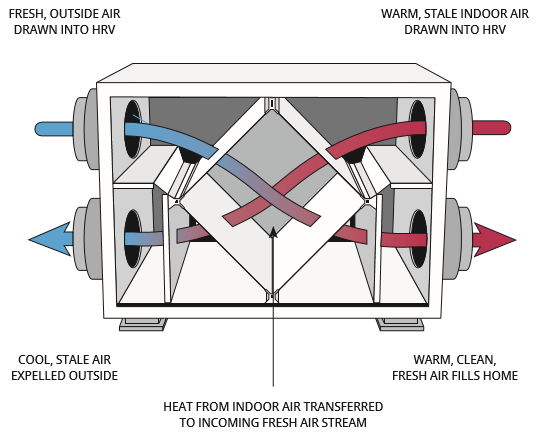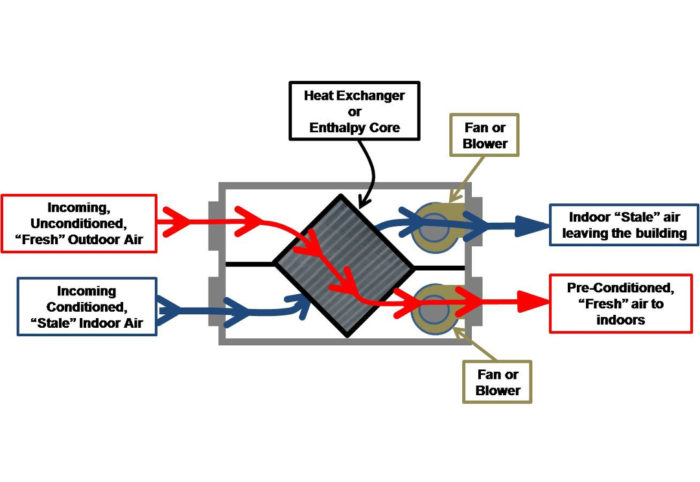The Ultimate Guide to HRV Setup in Residential Spaces
Wiki Article
Exactly How Heat Recovery Ventilation Enhances Indoor Air Quality and Reduces Energy Prices
Heat Recovery Ventilation (HRV) systems play an important role in improving indoor air quality while concurrently lowering energy expenses. By efficiently trading stagnant interior air with fresh outside air, HRVs assist keep excellent humidity and minimize contaminants. Additionally, their ability to recover warmth from outbound air minimizes the stress on heating and cooling systems. As power prices proceed to increase, recognizing the full possibility of HRV systems becomes progressively important for house owners and businesses alike.Comprehending Heat Recovery Ventilation Equipments

Heat recovery ventilation (HRV) systems play an important role in enhancing interior air high quality, especially in modern, energy-efficient buildings. These systems are made to transfer heat from the outbound stagnant air to the incoming fresh air, thus reducing power loss while keeping perfect temperature levels indoors. HRVs consist of a heat exchanger, fans, and ductwork, promoting the constant circulation of air. By eliminating indoor toxins and introducing fresh air, HRVs help to balance moisture levels, avoid mold and mildew growth, and minimize irritants. The performance of HRV systems exists in their capacity to recoup approximately 80% of the warmth from the exhausted air, promoting power preservation while ensuring a healthy interior setting. Their assimilation is vital in attaining lasting living techniques.
The Relevance of Indoor Air Top Quality
Indoor air quality (IAQ) is an essential variable affecting the health and wellness and health of occupants in any atmosphere. Poor IAQ can result in various health concerns, consisting of breathing problems, allergies, and exhaustion. In addition, it can worsen status quo such as bronchial asthma. Aspects contributing to reduced IAQ consist of pollutants from interior sources like cleaning representatives, mold, and inadequate air flow. As a result, maintaining excellent IAQ is vital for advertising a risk-free and comfortable living or functioning space. Efficient techniques to improve IAQ include regular tracking of air high quality, correct air flow systems, and lessening the usage of unsafe materials inside. By prioritizing IAQ, individuals can ensure a healthier setting that promotes productivity and overall lifestyle.Energy Performance Benefits of HRV Equipments
Numerous home owners and building supervisors are progressively identifying the energy performance benefits of warm recovery air flow (HRV) systems. By moving warmth from exhausted interior air to incoming fresh air, HRV systems markedly lower the power required for cooling and heating. This process reduces reliance on conventional a/c systems, resulting in lower power costs. Furthermore, HRVs help maintain a balanced interior climate, protecting against too much heating or cooling demands. The ability to recover up to 90% of the warm from outbound air likewise sustains sustainability efforts by decreasing general energy consumption. HRV systems add not just to cost financial savings yet also to a decreased carbon footprint, lining up with the growing focus on energy-efficient building practices.Installment and Maintenance Considerations
The effective execution of warm recovery air flow (HRV) systems needs careful factor to consider of installation and upkeep elements to guarantee peak efficiency. Appropriate positioning of the HRV unit is crucial, as it must be installed in an area that makes best use of air flow while minimizing sound disruption. Furthermore, ductwork must be properly sized and index insulated to stop energy loss. Regular maintenance, including filter substitute and system cleansing, is vital to secure ideal capability and indoor air high quality. Owners ought to develop a regular maintenance timetable to identify and attend to possible issues before they rise. Collaboration with skilled specialists throughout both installation and maintenance stages can boost the longevity and efficiency of HRV systems, eventually bring about better indoor environments and minimized power prices.
Real-World Applications and Success Stories
Exploring real-world applications of heat healing air flow (HRV) systems discloses their substantial influence on indoor air top quality and power performance throughout various settings. In domestic buildings, house owners have actually reported better air quality, leading to fewer allergies and respiratory system issues. Schools executing HRV systems have actually noted improved pupil concentration and minimized absence as a result of far better ventilation. Commercial buildings, such as workplaces and retail rooms, have experienced reduced power costs and boosted staff member productivity. A corporate workplace in a temperate climate attained a 30% decrease in energy bills after mounting an HRV system. These success click to find out more tales demonstrate that HRV technology not just adds to healthier environments but additionally supplies tangible financial advantages, making it an important financial investment for numerous markets.Often Asked Concerns
Can HRV Systems Decrease Irritants in Indoor Air?
The performance of HRV systems in decreasing indoor allergens mainly hinges on their capability to filter and exchange air. HRV Heat Recovery Ventilation. By constantly changing stale air, these systems can considerably decrease irritant degrees throughout indoor environments
Just How Does Moisture Affect HRV System Efficiency?
Moisture considerably affects HRV system efficiency; high levels can lead to condensation, lowering effectiveness, while low moisture might enhance air exchange. Stabilizing humidity is important for ideal procedure and preserving indoor air top quality.Are HRV Equipments Noisy During Procedure?
HRV systems can produce differing sound degrees throughout operation, relying on their style and installation. Some units operate quietly, while others may generate visible noise, particularly at higher air movement setups or when inadequately kept.What Is the Typical Lifespan of an HRV System?

Can HRV Solutions Be Utilized in All Environments?
HRV systems can be utilized in numerous climates, yet their efficiency may vary review - HRV Heat Recovery Ventilation. In extreme temperature levels, adjustments or supplementary systems could be essential to guarantee excellent efficiency and comfort while keeping indoor air top qualityReport this wiki page